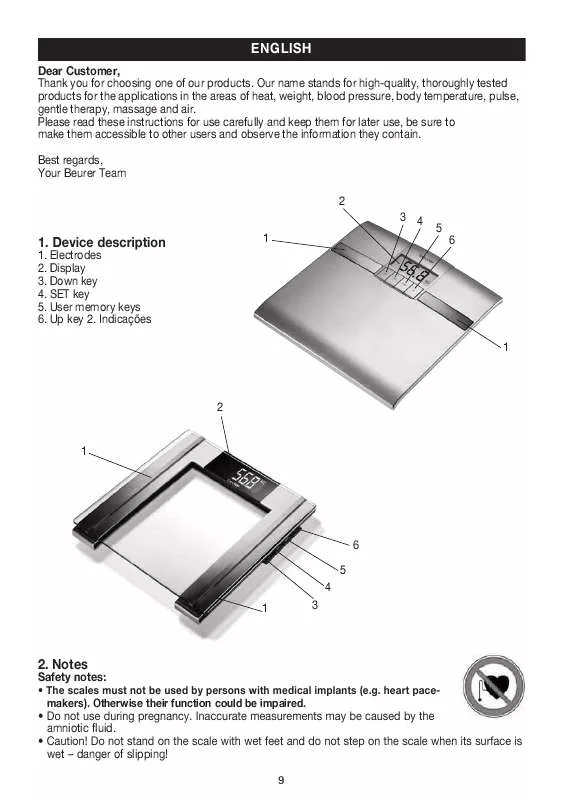Detailed instructions for use are in the User's Guide.
[. . . ] and heat sources which are too close (stove, heating radiators). Before submitting any complaint, first check the batteries and replace them if necessary. cerning the use of our scale, please contact your dealer or customer service.
3. Information on the diagnostic scale
The measuring principle of the diagnostic scale This scale operates according to the B. I. A. [. . . ] Physical effort for 30 minutes at least 2 to 4 times a week. Physical effort for 30 minutes at least 4 to 6 times a week. Intensive physical effort, intensive training or hard physical work for at least one hour daily. 11
5. 3 Taking measurements After all parameters have been entered, you can now measure your weight, body fat and the other data. Switch on the scale by briefly stepping on the platform. Step on the scale with bare feet and stand still on the electrodes. Important: There may be no contact between feet, legs, calves and thighs. Otherwise the measurement will not be performed correctly. The following data are displayed: Weight Body fat percentage Water percentage in % Muscle percentage Bone mass in kg
KG BF
This scale interprets body fat and body water with the following symbols: Body fat very good good and avarage poor Body water very good good poor
Body fat percentage The following body fat percentages are for guidance (contact your physician for further information). Man Woman
Age 10-14 15-19 20-29 30-39 40-49 50-59 60-69 70-100
very good <11% <12% <13% <14% <15% <16% <17% <18%
good 11-16% 12-17% 13-18% 14-19% 15-20% 16-21% 17-22% 18-23%
average 16, 1-21% 17, 1-22% 18, 1-23% 19, 1-24% 20, 1-25% 21, 1-26% 22, 1-27% 23, 1-28%
poor >21, 1% >22, 1% >23, 1% >24, 1% >25, 1% >26, 1% >27, 1% >28, 1%
Age 10-14 15-19 20-29 30-39 40-49 50-59 60-69 70-100
very good <16% <17% <18% <19% <20% <21% <22% <23%
good 16-21% 17-22% 18-23% 19-24% 20-25% 21-26% 22-27% 23-28%
average 21, 1-26% 22, 1-27% 23, 1-28% 24, 1-29% 25, 1-30% 26, 1-31% 27, 1-32% 28, 1-33%
poor >26, 1% >27, 1% >28, 1% >29, 1% >30, 1% >31, 1% >32, 1% >33, 1%
A lower value is often found in athletes. Depending on the type of sports, training intensity and physical constitution, values may result which are below the recommended values stated. It should, however, be noted that there could be a danger to health in the case of extremely low values. 12
Body water: The body water percentage is normally within the following ranges: Man Woman
Age 10-100
poor <50
good 50-65%
very good >65
Age 10-100
poor <45
good 45-60%
very good >60
Body fat contains relatively little water. Therefore persons with a high body fat percentage have body water percentages below the recommended values. With endurance athletes, however, the recommended values could be exceeded due to low fat percentages and high muscle percentage. Body water measurement with this scale is not suitable for drawing medical conclusions, for example concerning age-related water retention. Basically, a high body water percentage should be the aim. Muscle percentage: The muscle percentage is normally within the following ranges: Man Woman
Age 10-14 15-19 20-29 30-39 40-49 50-59 60-69 70-100 low <44 <43 <42 <41 <40 <39 <38 <37 normal 44-57% 43-56% 42-54% 41-52% 40-50% 39-48% 38-47% 37-46% high >57% >56% >54% >52% >50% >48% >47% >46% Age 10-14 15-19 20-29 30-39 40-49 50-59 60-69 70-100 low <36 <35 <34 <33 <31 <29 <28 <27 normal 36-43% 35-41% 34-39% 33-38% 31-36% 29-34% 28-33% 27-32% high >43% >41% >39% >38% >36% >34% >33% >32%
Bone mass: Like the rest of our body, our bones are subject to the natural development, degeneration and ageing processes. Bone mass increases rapidly in childhood and reaches its maximum between 30 and 40 years of age. Bone mass reduces slightly with increasing age. You can reduce this degeneration somewhat with healthy nutrition (particularly calcium and vitamin D) and regular exercise. With appropriate muscle building, you can also strengthen your bone structure. [. . . ] If necessary, remove the calluses from the soles of your feet. Repeat the measurement barefoot or, if necessary, moisten the soles of your feet slightly. Repeat the measurement barefoot or, if necessary, moisten the soles of your feet slightly. Repeat the measurement barefoot or, if necessary, moisten the soles of your feet slightly.
8. [. . . ]


